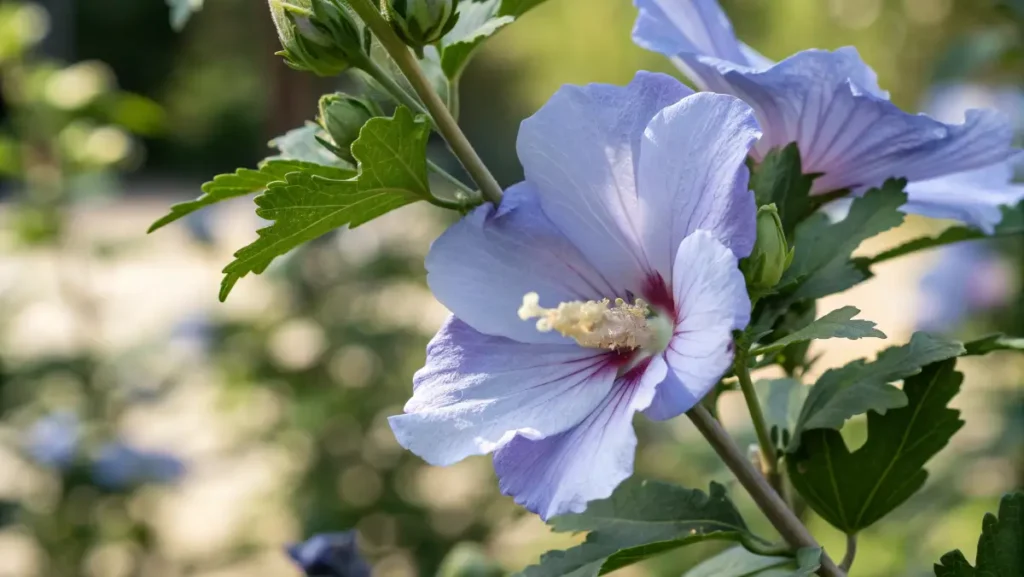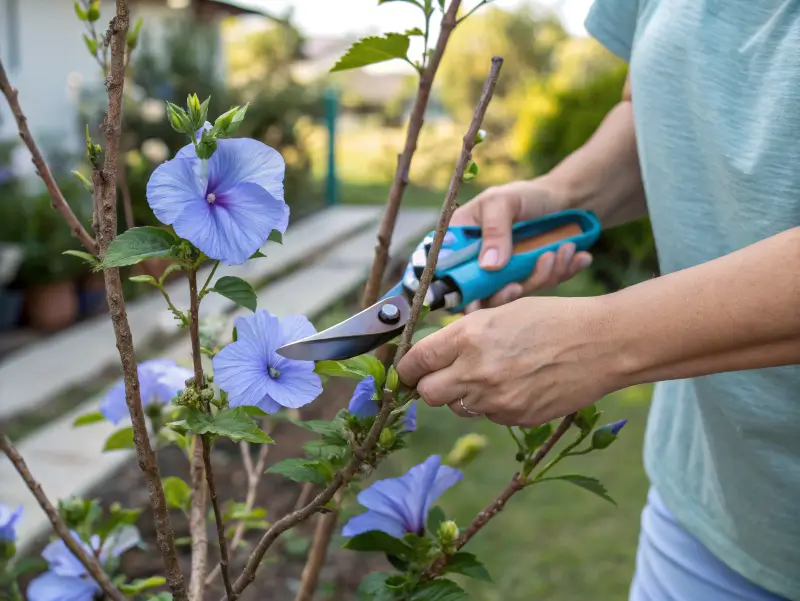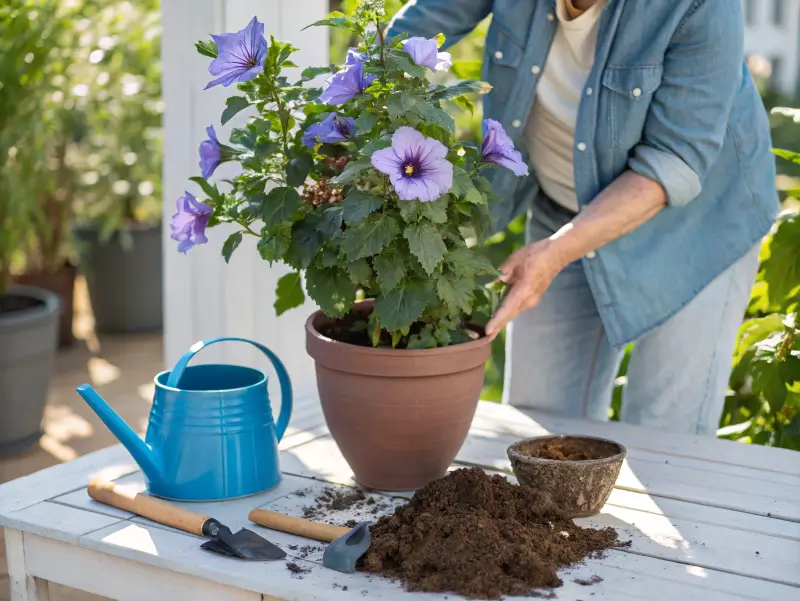
Blue hibiscus plant (Hibiscus rosa-sinensis) captivates gardeners with its stunning purple-blue blooms that shimmer like silk in sunlight. While true blue varieties don’t exist naturally, these gorgeous purple cultivars create convincing blue effects. Growing moderately to 4-10 feet tall, they’re surprisingly easy to care for with bright, filtered light and consistent watering. Their papery, dinner-plate-sized flowers are absolutely showstopping. Generally pet-friendly, though supervision around curious animals is wise.
Blue Hibiscus Plant Care
Let’s face it – caring for a blue hibiscus plant isn’t rocket science, but getting the basics right makes all the difference. I’ve learned this the hard way after watching my first blue hibiscus plant struggle through its first summer!
Light Requirements
Your blue hibiscus plant absolutely loves sunshine. Think of it as a sun-worshipper that needs at least 6-8 hours of direct sunlight daily to produce those gorgeous blooms we’re all after.
However, if you live in scorching hot climates (I’m looking at you, Arizona gardeners!), a bit of afternoon shade can actually help prevent stress. Moreover, your blue hibiscus plant will thank you for the protection during those brutal summer afternoons.
For indoor growers, place your hibiscus near your brightest south-facing window. You’ll love watching it chase the sun throughout the day!
Watering Needs
Here’s where many folks go wrong – blue hibiscus plants need consistent moisture but hate soggy feet. Think of it like Goldilocks: not too wet, not too dry, but just right.
Water deeply when the top inch of soil feels dry to touch. During hot summer months, this might mean watering every 2-3 days. In cooler weather, you can stretch it to once a week.
Pro tip: Water early in the morning so the leaves have time to dry before evening. Trust me, wet leaves overnight can lead to fungal problems that nobody wants to deal with.
Always check that excess water can drain away easily. Standing water is the fastest way to kill your beautiful blue blooms through root rot.
Soil Preferences
Blue hibiscus plants are pretty forgiving when it comes to soil, but they do have preferences. They thrive in well-draining soil with a slightly acidic to neutral pH between 6.0-7.0.
If you’re planting in garden beds, mix in some compost or aged manure. This not only improves drainage but also feeds your plant slowly over time.
For container growing, use a high-quality potting mix. I like adding a handful of perlite to store-bought mixes for extra drainage. Your hibiscus roots will appreciate the breathing room!
Temperature and Humidity
Most blue hibiscus varieties are surprisingly hardy. The popular ‘Blue Bird’ cultivar can handle temperatures down to about 5°F, making it suitable for USDA zones 5-9.
During winter, protection from harsh winds makes a big difference. Similarly, a thick layer of mulch around the base helps insulate the roots.
As for humidity, these plants aren’t too fussy. Normal outdoor humidity works fine, though they appreciate a bit more moisture in dry climates.
Fertilizer Guidelines
Feed your blue hibiscus plant regularly during the growing season (spring through early fall) with a balanced fertilizer. I use a 10-10-10 formula every 4-6 weeks, but organic options work beautifully too.
Avoid high-nitrogen fertilizers – they’ll give you lots of green leaves but fewer flowers on your blue hibiscus plant. Nobody wants that!
Stop fertilizing about 6 weeks before your first expected frost. This helps the plant prepare for winter dormancy.
Types of Blue Hibiscus Varieties
Now, let’s talk about the stars of the show! There are several types of plants commonly called “blue hibiscus plant,” and honestly, it can get confusing.
True Blue Hibiscus Species
Alyogyne huegelii, native to Australia, produces the truest blue flowers you’ll find. This shrub grows 6-8 feet tall and blooms almost year-round in mild climates.
The flowers are a gorgeous lavender-blue with darker centers. However, this species is only hardy in zones 9-11, so most of us northern gardeners need to grow it in containers.
Popular Blue Cultivars
Hibiscus syriacus (Rose of Sharon) offers several blue-toned varieties that are much more cold-hardy:
- ‘Blue Bird’ – Features soft blue flowers with red centers
- ‘Blueberry Smoothie’ – Produces ruffled purple-blue blooms
- ‘Blue Satin’ – Shows off semi-double blue flowers
- ‘Marina’ – Displays large, clear blue blooms
These cultivars bloom from mid-summer through fall, creating months of color when many other plants are winding down.
Hybrid Varieties
Plant breeders continue developing new blue hibiscus varieties with improved cold tolerance and flower color. Some newer hybrids show promise for extending the range where true blue hibiscus can grow outdoors year-round.
Cross-breeding between different species has also produced plants with unique color patterns and improved disease resistance.
Pruning Your Blue Hibiscus

Pruning might seem scary at first, but the blue hibiscus plant is actually quite forgiving. Plus, regular pruning keeps them looking their best and flowering heavily.
When to Prune
Late winter or early spring is the perfect time for major pruning, just before new growth begins. This timing allows you to see the plant’s structure clearly and won’t interfere with blooming.
Light deadheading throughout the growing season encourages more flowers. Consequently, you’ll get a longer blooming period and better plant appearance.
Remove any dead, damaged, or crossing branches anytime you notice them. Don’t wait for pruning season if something needs immediate attention.
Pruning Techniques
For young plants, focus on shaping rather than heavy cutting. Pinch growing tips to encourage bushier growth.
Mature plants can handle more aggressive pruning. Cut back up to one-third of the plant’s height to maintain size and shape.
Always use clean, sharp pruning shears. Ragged cuts invite disease problems that could affect your plant’s health.
Make cuts just above outward-facing buds to encourage open growth. This improves air circulation and reduces disease risk.
Post-Pruning Care
After pruning, apply a balanced fertilizer to support new growth. Your blue hibiscus plant will use this energy to develop strong branches and flower buds.
Watch for new growth in 2-3 weeks. If growth seems slow, check that you’re providing adequate water and sunlight.
Don’t panic if your plant looks sparse after pruning – hibiscus plants bounce back quickly with proper care.
Blue Hibiscus Plant Propagation
Want more blue hibiscus plants? Who doesn’t! Fortunately, these beauties are relatively easy to propagate using several methods.
The blue hibiscus plant responds well to propagation, making it simple to expand your collection or share with friends.
Stem Cutting Method
Summer cuttings root most reliably. Take 4-6 inch cuttings from healthy, non-flowering shoots in the morning when plants are well-hydrated.
Remove lower leaves and dip the cut end in rooting hormone. This isn’t absolutely necessary, but it definitely improves success rates.
Plant cuttings in a mix of peat and perlite. Keep the soil consistently moist but not waterlogged. Most cuttings root within 4-6 weeks.
Bottom heat from a heat mat speeds up rooting significantly. If you don’t have one, place containers on top of your refrigerator – the gentle warmth helps a lot.
Seed Propagation
Growing a blue hibiscus plant from seed takes patience, but it’s incredibly rewarding. Collect seeds from spent flowers in fall after they’ve dried naturally on the plant.
Soak seeds overnight before planting to improve germination rates. Plant in seed-starting mix and keep consistently moist.
Germination can take anywhere from 1-4 weeks. Be patient – some seeds are just slower than others!
Seedlings need bright light but protection from direct sun until they’re established. Transplant to individual pots when they have 2-3 sets of true leaves.
Layering Techniques
Ground layering works well for low-hanging branches. Bend a flexible branch to the ground, wound the bark slightly, and cover with soil.
Keep the buried section moist, and roots typically develop within 6-8 weeks. Once rooted, you can cut the new plant from the parent.
This method has a high success rate because the cutting remains attached to the parent plant while developing roots.
Potting and Repotting Guidelines

Container growing opens up blue hibiscus plant possibilities for gardeners in colder climates. Plus, you can move plants to protect them from harsh weather.
Container Selection
Choose pots that are at least 18 inches wide for mature plants. Drainage holes are absolutely essential for any blue hibiscus plant – I can’t stress this enough!
Terra cotta pots work great because they’re porous and help prevent overwatering. However, they dry out faster, so you’ll need to water more frequently.
Plastic containers retain moisture longer, which can be helpful in hot, dry climates. Just be extra careful not to overwater.
Potting Mix Composition
Use a high-quality potting mix designed for flowering plants. Avoid garden soil, which becomes too compacted in containers.
I like mixing in about 20% additional perlite for extra drainage. Your hibiscus roots need oxygen just as much as they need water.
Adding compost provides slow-release nutrients and improves soil structure. About 10-15% compost in the mix works perfectly for any blue hibiscus plant.
Test your potting mix pH if possible. Blue hibiscus prefers slightly acidic to neutral soil (6.0-7.0 pH).
Repotting Schedule
Young plants may need annual repotting as they grow quickly. Look for roots growing through drainage holes as a sign they need more space.
Mature plants can often go 2-3 years between repottings. However, refresh the top few inches of soil annually with fresh potting mix.
Spring is the best time for repotting, just as new growth begins. The plant recovers more quickly during active growing periods.
When repotting, go up only one pot size. A too-large container holds too much moisture and can lead to root problems.
Common Pests and Diseases
Like most flowering plants, the blue hibiscus plant can attract some unwanted visitors. The good news? Most problems are easily managed with early intervention.
Frequent Pest Problems
Aphids love tender new growth and flower buds. You’ll often find them clustered on shoot tips, sucking plant juices.
A strong spray of water knocks most aphids off the plant. For persistent infestations, insecticidal soap works well and won’t harm beneficial insects.
Whiteflies flutter around when you disturb the plant. These tiny white insects also feed on plant juices and can weaken your hibiscus over time.
Yellow sticky traps help monitor and control whitefly populations. Place them near affected plants for best results.
Spider mites appear during hot, dry weather. Look for fine webbing on leaves and tiny specks moving around.
Increase humidity around the plant and rinse leaves regularly. Predatory mites can also help control spider mite populations naturally.
Disease Prevention
Fungal diseases thrive in humid conditions with poor air circulation. Space plants properly and avoid overhead watering when possible.
Root rot from overwatering kills more blue hibiscus plants than any other problem. Always check soil moisture before watering, and make sure containers drain well.
Remove fallen leaves and debris around plants regularly. This eliminates places where disease organisms can overwinter and reinfect plants.
Integrated Pest Management
Encourage beneficial insects by planting flowers like Yellow Chrysanthemum and Red Chrysanthemum nearby. These attract predatory insects that help control garden pests naturally.
Regular inspection helps catch problems early when they’re easier to manage. Check your plants weekly during the growing season.
Chemical controls should be your last resort. Most blue hibiscus plant pest problems can be managed effectively with cultural practices and organic methods.
Common Blue Hibiscus Issues
Even experienced gardeners run into problems sometimes with their blue hibiscus plant. Here are the most common issues and their solutions.
Leaf Problems
Yellowing leaves usually indicate watering issues – either too much or too little. Check soil moisture and adjust your watering schedule accordingly.
Lower leaf drop is normal as plants age, especially in fall. However, sudden leaf drop often means the plant is stressed from environmental changes.
Brown leaf tips typically result from low humidity, fluoride in tap water, or fertilizer burn. Try using distilled water and reducing fertilizer frequency.
Curling leaves can indicate pest problems, heat stress, or watering issues. Inspect carefully for pests and evaluate growing conditions.
Blooming Issues
No flowers frustrates every blue hibiscus plant gardener! Usually, this means insufficient sunlight, too much nitrogen fertilizer, or the plant is too young to bloom.
Move plants to sunnier locations if possible. Also, switch to a low-nitrogen, high-phosphorus fertilizer to encourage blooming.
Bud drop happens when plants experience stress from watering changes, temperature fluctuations, or pest problems. Maintain consistent care routines.
Faded flower colors can result from intense heat, aging, or nutrient deficiencies. Provide afternoon shade in extreme heat and maintain regular fertilizing.
Growth Problems
Stunted growth often indicates root problems, inadequate nutrition, or poor growing conditions. Check roots for health and adjust care as needed.
Leggy growth happens when plants don’t get enough light. They stretch toward available light, becoming weak and spindly.
Wilting plants need immediate attention. Check soil moisture first – both drought and overwatering cause wilting, but the solutions are opposite!
According to the USDA Plant Hardiness Zone Map, knowing your specific zone helps determine which blue hibiscus plant varieties will thrive in your area.
FAQ
Do blue hibiscus exist?
Yes, true blue hibiscus varieties definitely exist! While they’re less common than red or pink varieties, plants like Alyogyne huegelii produce gorgeous blue flowers. However, many plants sold as “blue hibiscus” are actually purple or lavender-blue rather than true blue.
How do you take care of a blue hibiscus plant?
Blue hibiscus plant care is straightforward: provide full sun, water consistently when soil feels dry, use well-draining soil, and fertilize regularly during growing season. Protect from frost in colder climates and prune in late winter for best results.
What is the best blue hibiscus?
For true blue color, Alyogyne huegelii can’t be beat, though it’s only hardy in warm climates. For cold-hardy options, Hibiscus syriacus ‘Blue Bird’ offers reliable blue blooms and can survive much colder temperatures.
How to make blue hibiscus?
You can’t artificially create blue hibiscus plant flowers through dyes or soil amendments. True blue varieties must be grown from specific cultivars or species that naturally produce blue flowers. Don’t fall for myths about adding food coloring to water – it doesn’t work and can harm your blue hibiscus plant!
The blue hibiscus plant brings something special to any garden with its unusual flower color and reliable blooming habit. Whether you choose a true blue species or a cold-hardy cultivar, these plants reward good care with months of stunning flowers. Start with the basics – sun, water, and good drainage – and you’ll be amazed at how these tropical beauties can transform your garden space.

2 thoughts on “Blue Hibiscus Plant: Proven Care & Growing Guide”
Comments are closed.